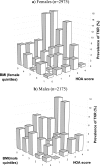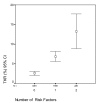Hand Osteoarthritis Severity is Associated with Total Knee Joint Replacements Independently of BMI. The Ages-Reykjavik Study
- PMID: 21552415
- PMCID: PMC3087214
- DOI: 10.2174/1874312901105010007
Hand Osteoarthritis Severity is Associated with Total Knee Joint Replacements Independently of BMI. The Ages-Reykjavik Study
Abstract
Objective: To identify factors associated with having total knee replacement due to osteoarthritis in the AGES-Reykjavik Study, a large population based study of elderly Icelanders.
Methods: Information about total knee and hip joint replacements (TKR,THR) and hand OA (HOA) severity was available in 2195 males and 2975 females, mean age 76±6 years. The prevalence of TKR was 223 (4.3%) and THR 316 (6.1%). We performed a backwards binary logistic regression analysis of possible OA associated variables including age, gender, abdominal circumference, BMI, hs-CRP, cholesterol, statin use, bone mineral density of the spine, education and smoking history as well as HOA severity and the presence of THR.
Results: Only three factors showed significant associations with TKR; BMI (p=3.5x10(-17)), HOA severity (p=2.9x10(-8)) and THR (p=0.0002). The highest quintile of BMI was associated with a fivefold risk of TKR compared with the lowest (8% vs 1.6%), and severe HOA had a 2.4 fold risk compared with those with no HOA (8% vs 3.3%). There was no statistical interaction between BMI and HOA. Thus, individuals with BMI<23.5 with no evidence of HOA had a prevalence of TKR of 1.1%, while those with BMI>30.3 and severe HOA had a prevalence of 13.4%.
Conclusions: Hand and hip osteoarthritis in conjunction with BMI are strongly associated with the prevalence of TKR due to osteoarthritis. Together, BMI and HOA severity seem to contribute to the majority of the total TKR prevalence. While BMI has long been recognized as the major risk factor for TKR, the influence of osteoarthritis at other sites may have been underestimated.
Keywords: AGES-Reykjavk Study.; Body Mass index (BMI); Epidemiology; hand osteoarthritis; knee joint replacement; knee osteoarthritis.
Figures



References
-
- Felson DT, Lawrence RC, Dieppe PA, et al. Osteoarthritis: new insights. Part 1: The disease and its risk factors. Ann Intern Med. 2000;133:635–46. - PubMed
-
- Abbate LM, Stevens J, Schwartz TA, Renner JB, Helmick CG, Jordan JM. Anthropometric measures, body composition, body fat distribution, and knee osteoarthritis in women Obesity (Silver Spring) 2006;14:1274–81. - PubMed
Grants and funding
LinkOut - more resources
Full Text Sources
Research Materials
Miscellaneous
